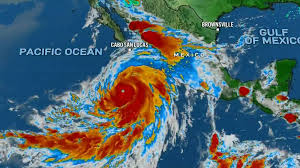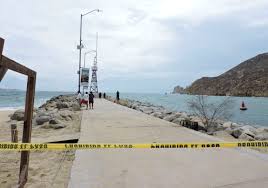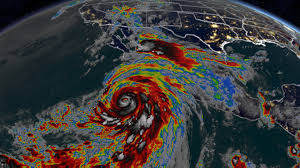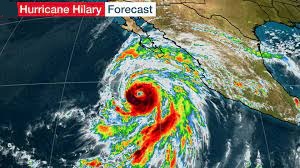Cyclone Hillary Approaching Mexico-California: A Category 4 Storm
A powerful cyclone named Hillary is on a trajectory towards California, USA, with its current path leading it through Mexico. According to reports from Reuters, It is categorized as a fearsome Category 4 storm.

The impending impact raises concerns that three US states – California, Arizona, and Nevada – might witness a year’s worth of rainfall within a single day.
Forecasted Deluge: 10 Inches of Rain for Mexico’s Baja California
As per the New York Times, an alarming forecast predicts up to 10 inches of rainfall over the upcoming 48 hours in Mexico’s Baja California region. This dire prediction has escalated concerns of potential flooding not only in Mexico but also in the vulnerable regions of California.

The US National Oceanic and Atmospheric Administration’s (NOAA) projections indicate that it will initially strike Mexico before advancing towards the Californian coast.
Historical Parallels: A Potential Landfall in California after 84 Years
It’s path has been steadily advancing northward. Should the cyclone hit California first, it would mark the most substantial northern storm impact in over eight decades. The last occurrence of such magnitude was witnessed 84 years ago. In an unprecedented move, a Category 4 hurricane warning has been dispatched for Southern California, reflecting the severity of the impending threat.
Preparations and Measures:
As it bears down, preparations are in full swing. The renowned resort city of Cabo San Lucas, Mexico, is expected to face the brunt of the storm’s impact. Local authorities have taken proactive steps by closing non-essential public activities and schools, a measure aimed at safeguarding citizens.

The heightened risk has compelled residents of high-risk zones in Tijuana to relocate to safer areas. In anticipation of the it’s fury, a network of 80 shelters has been erected, capable of accommodating approximately 9,000 individuals.
Unveiling the Fury:
They are circular atmospheric phenomena that originate over warm oceanic waters. Upon making landfall, they unleash torrents of heavy rain and powerful winds. These winds have the potential to cause destruction, toppling trees, vehicles, and even buildings.

Disturbances within the atmosphere, driven by robust winds and accompanied by precipitation, hail, or snow, are referred to as storms. Cyclones, distinct from common storms, are born over the sea and possess heightened intensity and danger.
A Global Perspective:
Cyclones, hurricanes, and typhoons are synonymous terms. A tropical cyclone is a fast-spinning storm with a center of low pressure. It has swirling thunderstorms and strong winds that bring heavy rain and gusts of wind. These storms go by different names depending on where they are and how strong they are. They can be called hurricanes, typhoons, tropical storms, cyclonic storms, tropical depressions, or just cyclones.
A hurricane is a powerful tropical cyclone found in the Atlantic Ocean or the northeastern Pacific Ocean. A typhoon is like a hurricane but happens in the northwestern Pacific Ocean. In the Indian Ocean, South Pacific, or sometimes the South Atlantic, similar storms are called “tropical cyclones.” In the Indian Ocean, really strong ones can also be called “severe cyclonic storms.”

These phenomena receive varied appellations across different regions worldwide. The most extensive cyclone in history formed in 1979 over the northwest Pacific Ocean, spanning a staggering diameter of 2,200 kilometers – almost half the size of the United States.
Understanding the Slowdown: It’s Behavior over Time
It is typically experience a weakening trend within hours or days after encountering land. This decline stems from their diminishing access to the energy and moisture sourced from warm oceanic waters.
However, despite the depletion, it is often traverse considerable distances inland, leaving destruction in their wake through heavy rainfall and formidable winds. Although they can persist for several days or weeks, they tend to lose momentum and disperse as they cross expansive land areas or colder seas.
For more news please visit – https://universenews.co.in/category/science-technology/
Pics Courtesy: Google
